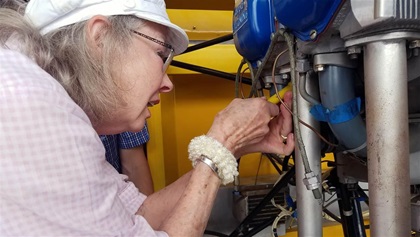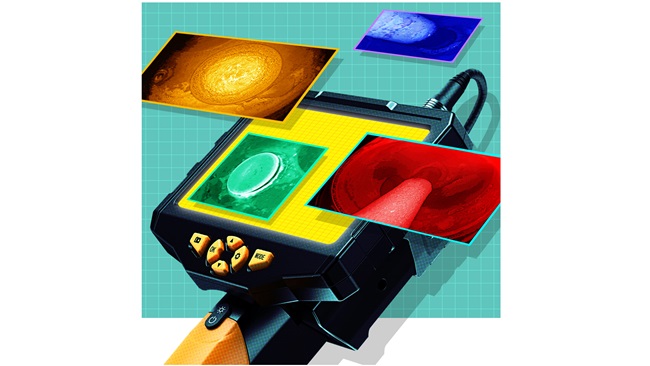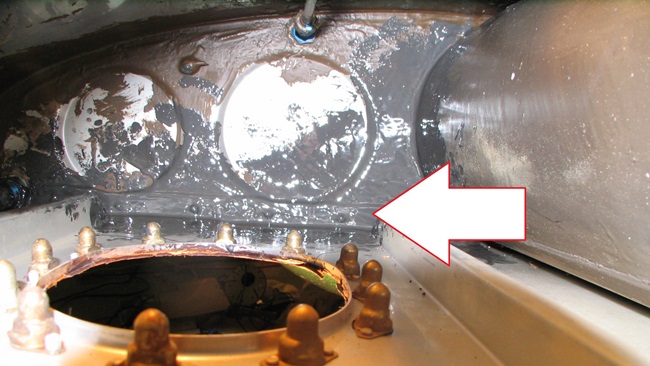Maintenance Training: A gateway to a career
Light sport repairman course can lead to bigger prospects—and aircraft
By Christopher L. Freeze
Each June, pilots and aviation enthusiasts have the opportunity to gather in the Appalachian foothills for three weeks to train for and earn a little-known but powerful privilege in aviation: the light sport repairman—maintenance certificate.

Fred Dyen, an aviation maintenance professor, flight instructor, and former Alaskan bush pilot, built the aviation maintenance education program at Blue Ridge Community College (BRCC), in Weyers Cave, Virginia, from nothing in 2007, and first offered the light sport repairman—maintenance (LSRM) course in 2009. Today, BRCC is one of only two places in the United States to provide light sport repairman maintenance training and is the only one at a public institute.
“I think light sport aviation has a tremendous future and an underutilized transition to potentially greater things,” Dyen said. “Our school offers this comprehensive, 120-hour training course to qualify students for the LSRM certificate, and we see students from around the country, ranging in age from 21 to 80, take our courses. While most have an aviation background, 25 percent are newcomers—looking to see what aviation has to offer.”
Dyen explained that the program is 65 percent lecture and 35 percent practical training. Light sport repairman students have access to resources from the college’s airframe and powerplant program. “Plus, it is simply a great way for someone to discover if maintenance is truly something they want to pursue.”
Starting with the regulations
Every morning of the course starts with an in-depth analysis of FAA regulations and their applicability to light sport aircraft, as well as exercises in proper documentation and maintenance recordkeeping.
“The correct documentation of completed maintenance work is nearly as important as the correct completion of that work,” Dyen tells the students in his classes. “The rules and regulations can take only a few hours to learn, but the mastery of them is just beginning for most students. The course’s goal in this is to get them to know where to find the answers to their questions.”
Working on the airframe
A significant part of the course takes place at BRCC’s hangar, located at nearby Shenandoah Valley Regional Airport (SHD). There, the school maintains an aircraft repair shop, complete with engine cutaways, aircraft system training aids, and a full-size paint booth. Several donated aircraft are stored on the flight line and in the hangar, where they are frequently called upon for students to damage and then repair. The latest addition: a fabric-covered Avid Flyer.
An estimated 3,000 aircraft are re-covered annually. “A lot of mechanics may downplay the need to skillfully handle materials like Dacron or Ceconite,” Dyen said. “But with that many still flying, a technician who can master an aircraft covering system like Poly-Fiber will possess a valuable skill for the foreseeable future.”
A leather artisan and private pilot from Virginia, Chuck Pinnell was surprised by some of the course’s material. “I was astonished to see the interworking and details of a fabric-covered airplane, and the structural strength of such a malleable material. You simply don’t imagine something so light supporting the loads of flight.”
Earning an LSRM certificate also enables someone to start making money as a mechanic after just three weeks of training.In addition to fabrics, students also get experience repairing composites under the guidance of Cindy Foreman, an industry expert and the author of the textbook Advanced Composites. “Since I started in the late 1970s, the use of composites has only increased. Aircraft have gone from just a few surfaces and controls being composite to, nowadays, virtually entire aircraft,” Foreman said. “The weight savings, combined with their inherent strength, is making composite construction more widespread in light sport aircraft, and the students need to be ready and prepared to conduct such repairs in the future.”
Engines and propellers
While an estimated 85 percent of light sport aircraft are powered by Rotax engines, which require factory training to conduct warranty-covered work, course participants are taught the basics of working on any piston-powered engine, from measuring cylinder compression and safely changing oil to adjusting the ignition timing and replacing hoses and cables.
Students discover the vital importance of unmarred propellers to flight, and how even a little damage can affect safe operations.
“As a pilot, I have approached the propeller on a typical preflight inspection rather cavalierly,” Pinnell said. “Now, in the wake of this course, I have a completely new appreciation for all those nicks and scratches that I would have previously overlooked. I now look at the blade face with a completely new perspective. All pilots should not just take heed of the importance of it, but should consider this training to simply learn more about the machines that they fly.”
 Fay Taylor, a private pilot also from Virginia, attended because she was looking to volunteer her time at a local mechanic shop. “I came to learn as much as I could as a refresher and get a glimpse at the future of flying,” she said. The course provided Taylor with a structured approach to some of aviation’s mechanical basics. “Before this course, I knew very little about mechanics, engineering, and everything that goes into making and keeping an airplane flying. I took it all for granted. But now, I can visualize the processes so much easier than I could have ever on my own.”
Fay Taylor, a private pilot also from Virginia, attended because she was looking to volunteer her time at a local mechanic shop. “I came to learn as much as I could as a refresher and get a glimpse at the future of flying,” she said. The course provided Taylor with a structured approach to some of aviation’s mechanical basics. “Before this course, I knew very little about mechanics, engineering, and everything that goes into making and keeping an airplane flying. I took it all for granted. But now, I can visualize the processes so much easier than I could have ever on my own.”
Future prospects
Dyen cites the growing need for mechanic and technicians of all sorts. “Aviation mechanics are highly sought outside of our industry because of the excellent training that comes with working on aircraft. Today, A&Ps are being hired by automobile manufacturers, elevator servicing companies, and even Nascar teams.”
Earning an LSRM certificate also enables someone to start making money as a mechanic after just three weeks of training. Jason Ploen, a retired U.S. Army officer and private pilot from Maryland, said, “My flight school at Bay Bridge Airport has just set up a maintenance shop. Literally the day I get home after completing this course, I will be in the shop—putting my new skills to use by helping with a 100-hour inspection on an RV–12.”
But one of the secrets of the LSRM certificate is the power of its portability. Unlike a standard repairman certificate which is connected to employment with an FAA-certificated repair station, commercial operator, or air carrier, the LSRM is tied directly to the certificate holder. This means that, after working in the field for 30 months under his or her own supervision, an LSRM holder is qualified to take the A&P testing and add that certificate as a rating without ever attending an A&P school.
Mike Zidziunas was the first LSRM in the country to earn his A&P under this rule in 2009. He saw the potential in light sport aircraft and enrolled in one of the first LSRM courses offered. He has gone on to leverage the opportunities the certificate presents, opening a Rotax service center, working with manufacturers assembling LSA aircraft, and continuing his training by earning an inspection authorization.
Jake Sikes, a U.S. Army veteran and private pilot from Georgia, hopes to follow in Zidziunas’ footsteps. “This certificate offers a guy like me, who doesn’t have a lot of time, a great way to get into working on airplanes, save money, and even start a business servicing other LSA aircraft. At the very least, I can save a lot on maintenance by doing my own work and inspections on my plane.”
In addition to the FAA LSRM certificate, participants are also able to test for additional technical certifications from Michelin and Snap-On, and get student discounts on major tool purchases from Snap-On, Matco, and Proto. The college also offers a career studies certificate to qualified students, meaning it is eligible for VA educational benefit use.
A distance-learning option for the A&P course recently was approved, and Dyen said he hopes to offer a distance-learning option for the LSRM course. LSRM students would take the lectures online at their leisure from home, and do the required mechanical tasks on site for a few days, perhaps a couple of weekends. For A&P candidates, it would be longer.
Mike Okasinski, a mental health professional and private pilot from Ohio, strongly recommended the training to anyone, saying, “Even if someone has no interests in turning a wrench themselves, the curriculum covers a wide breadth of content that makes anyone with a passion for aviation more knowledgeable and helpful for things like an owner-assisted inspection or just buying an airplane.”
Christopher L. Freeze is a commercial pilot, flight instructor, and writer living in the Washington, D.C., area.


